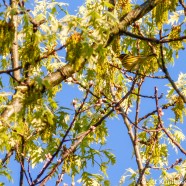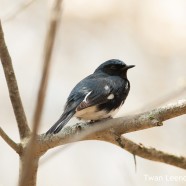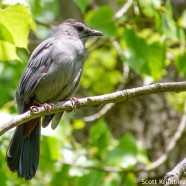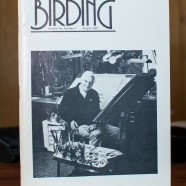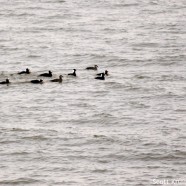Cape May Warbler
This male Cape May Warbler (Setophaga tigrina) is hidden in the very tops of this oak tree, its bright and vibrant yellow, orange and brown shades somehow camouflaged in the growing leaves and glowing sunlight. The easiest way to “spot” this bird was to hear its voice, but even the song of the species is a high-pitched, thin and quick little tune. These record photos are actually past record shots of a bird that I heard moments after waking up, with it in the always helpful oak outside my window. Being half awake I was not fully processing what I was hearing among a chorus of...
Read MoreBlack White & Blue
Here are a couple more goodies from Twan’s yard, a male Black-and-white Warbler (Mniotilta varia) and a male Black-throated Blue Warbler (Setophaga caerulescens). Both certainly look exactly as they sound! Please be sure to eBird all of your yard birds, as Twan did.
Read MoreGray Catbirds Coming
We will soon be inundated by the deceptive and incorrect sound of felines as the Gray Catbird returns in full force to our neighborhoods across America. They really have about as literal a common name as any bird. Apart from their gray bodies and black cap you can also see a hint of the rusty-colored feathers under these bird’s tails. Meow to you, too.
Read MoreBird Book Wars: The Emperor Strikes Back
Our friend Patrick Comins, Audubon Connecticut Director of Bird Conservation, walked into my office with this a few days ago – it is the American Birding Association’s Birding journal from August 1981, Volume XIII, Number 4, featuring our own Roger Tory Peterson on the cover. Appropriately shown in his studio the story is hilariously titled, “Bird Book Wars: The Emperor Strikes Back” with an introduction and four reviews of the Fourth Edition of his legendary A Field Guide to the Birds. It also features a response by Roger Tory Peterson himself. They even made the...
Read MoreSpiffy Surf Scoters
These Surf Scoters (Melanitta perspicillata) sure are looking spiffy! Their spring colors of sorts stand out on the gray and still cold water. Waterfowl migration is well underway now as species like the “skunk-headed coot” seen here are on the way out until next fall.
Read More



